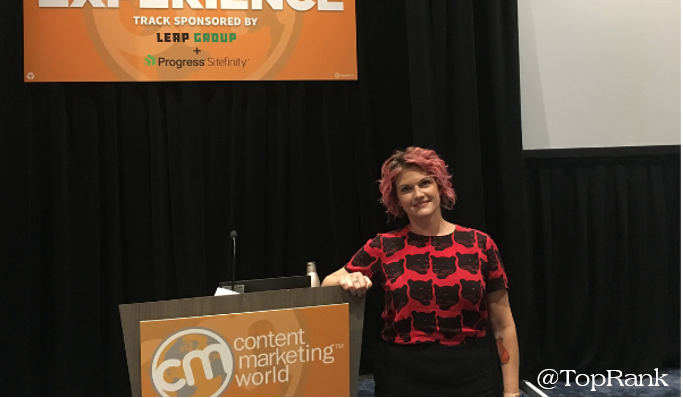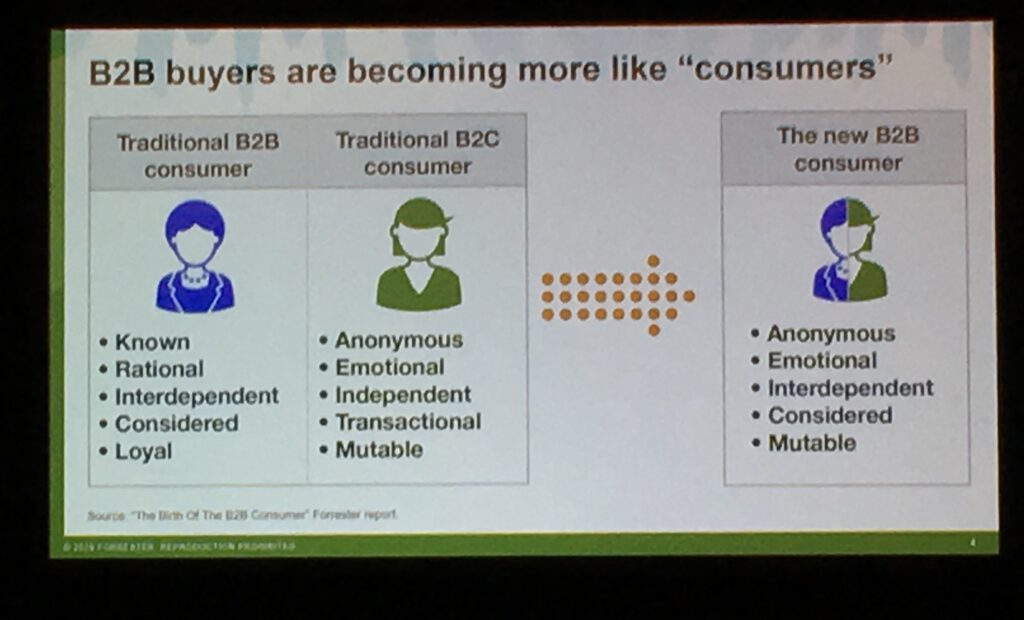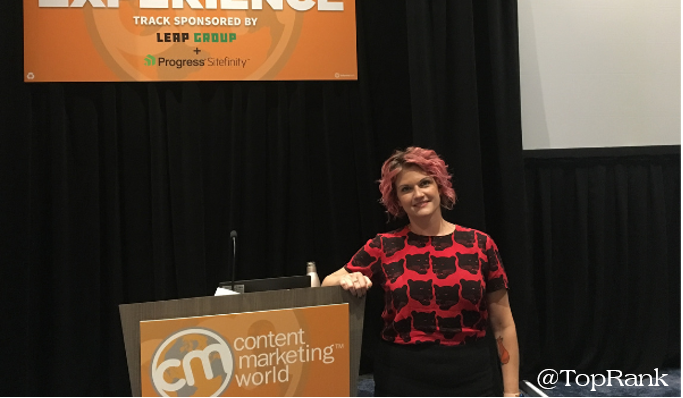
Forrester’s April Henderson started her Content Marketing World 2019 session with a classic cautionary tale:
Johann Rall was fighting for the British at the turning point of the Revolutionary War. The night before the Battle of Trenton, he was out celebrating at the home of a local Loyalist merchant. That merchant had seen General Washington amassing his forces and knew the attack was coming.
So what did the merchant do? He created relevant content! He wrote Rall a note and slipped it across the table. Rall nodded, put the note in his pocket… and continued his evening of revelry. The British were caught unawares, and the tide of the war began to turn. That lack of content engagement might be how America won the war.
In other words, when content doesn’t connect with your audience, the results can be disastrous.
Capturing the Attention of a New Breed of B2B Consumer
Right now B2B content is missing the mark, and missing it by a wide margin. Based on Forrester’s own research, 65% of B2B buyers say vendors give too much content. Over half say much of the material they get is useless. Seventy percent said the material is focused more on style than substance.
How can marketing professionals with mountains of research and tons of experience be getting it so wrong? According to April, it’s a failure to adapt to changing buying habits:

April says the new B2B consumers “aren’t buying your product; they buy into your approach to solving their problems.” They don’t want to hear about product features, awards your brand has won, or even how your product compares to a competitor.
They want to know that you hear their problems, you understand them, you sympathize, and you have solutions.
Using Data to Drive Empathetic Content
We usually think of data and emotion as two separate types of appeal (logos and pathos, for those who remember high school debate club). But according to April, you can actually make more effective emotional appeals by using data.
After all, you’re showing the consumer you understand them. The best way to understand them is by ethically using the data you’ve got to inform your marketing. With the right data on board, you have a credible, authentic story to tell about how you can help your potential consumer.
To drive the point home, April shared a case study from a company called LogMeIn. This security solutions provider commissioned a survey to see how sophisticated businesses were with their security.
When it came time to present the findings, they didn’t just create a white paper and lock it behind a gate. Instead, they used the report data to create a maturity model, and that model became the basis for a self-assessment calculator.
Consumers could take the assessment for their business and see how they measured up against competitors. Then they were offered the entirety of the original research, ungated, and presented with a contact form for customized recommendations. Those who filled out the form, says April, were already well into developing a relationship with the brand. They were practically sales qualified leads already.
LogMeIn built that affinity by helping customers learn about themselves and their competitors, providing a ton of value that was keyed to customers needs, not the brand’s solutions.
Shouldn’t B2B Content Be Logical, not Emotional?
Even with overwhelming evidence about the power of emotional appeal, it’s easy to think of emotion as somehow less real, less effective for B2B buyers. April disagrees. “B2B decisions are really complex, but we don’t have some separate brain we engage to make those decisions,” she says. B2B buyers don’t somehow switch off their emotions while they’re at work.
Getting started with that emotional component is as easy as thinking about an average day in your ideal buyer’s life. Think about the whole person, not just the buyer part. What do they really want? It might break down like this:
- I want to get off work in time to pick up my daughter from school
- So I want to process these invoices faster
- So I need to automate this process with software
With these points in mind, instead of showing how your software is x times faster than the competitor, show the parent getting out of work on time and picking up their kid at school. That’s a story that your buyer can relate to, whether they’re an IT decision influencer or a C-suite decision maker.
Make Human Connections across Channels
So you’re collecting data and creating empathetic content based on your findings. The next step is to humanize your buyer’s journey and see it holistically. You need to meet your consumers where they are, not try to herd them into your preferred channel.
April cited Forrester research that says the average buyer’s journey crosses at least twelve different channels. How can marketers meet the buyer on all those different media? Content atomization.
You don’t have to create tons of new content for each channel, April says. Instead, start with cornerstone content, a large asset that can be broken down and repurposed in multiple formats. This type of modular content helps promote consistency across channels.
Another way to repurpose content is to add customizable or interactive elements. In another Forrester survey, 50% of B2B buyers said they wanted interactive, web-based assets rather than static PDFs. And 61% said they want to input information to generate a customized output.
Keep Your Messaging Consistent – For Sales, Too
There’s one more challenge to making content more empathetic: In a single face-to-face meeting, a sales rep will either validate or totally negate your branding efforts. It only takes one off-brand conversation to wreck the relationship you’ve been nurturing.
As such, April says, our work doesn’t stop at the sales hand-off. Sales leadership should be included as a stakeholder in the entire content program, from the planning stages onward. That way, marketing can create more relevant content, and sales can learn how to use it more effectively.
One key way content marketers can help sales is by helping develop data-based tools, like LogMeIn’s self-assessment calculator. April identified four key attributes of a great sales enablement tool:
- It facilitates clients sharing the scope and scale of their needs
- It Includes relevant comparison data from peers
- It provides personalized output to leave behind with the customer
- It sets the expectation for a sales followup
To Get Your Content Seen, Show Your Audience You See Them First
Is your B2B content helping people solve problems, or is it just pointing them at your product? If it’s the latter, you’re missing the mark. April demonstrated how data can help you make an emotional connection with potential buyers. Show them you understand their problems – even the ones that go beyond your particular solution. Don’t hesitate to show your solution in the broader context of people’s lives, and don’t shy away from an emotional appeal.
Need more Content Marketing World in your life? The conference is over, but we have plenty of takeaways still to come. Follow @leeodden, @NiteWrites, @azeckman, and @toprank on Twitter for real-time insights.



